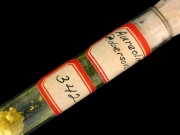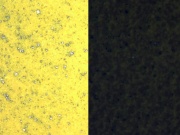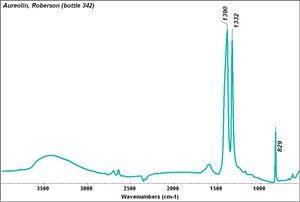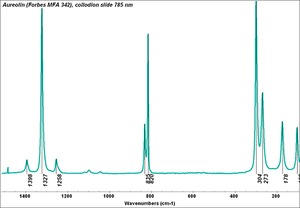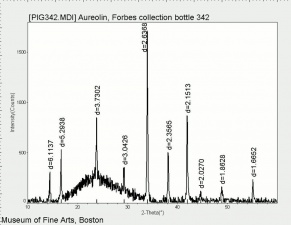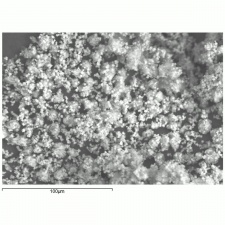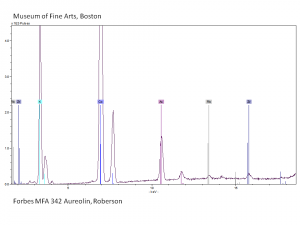Difference between revisions of "Aureolin"
| (8 intermediate revisions by 2 users not shown) | |||
| Line 1: | Line 1: | ||
[[File:342 aureolin.jpg|thumb|Aureolin]] | [[File:342 aureolin.jpg|thumb|Aureolin]] | ||
== Description == | == Description == | ||
| − | + | [[File:aureolin C100x.jpg|thumb|Aureolin]] | |
A brilliant, transparent yellow pigment also known by the name cobalt yellow. Cobalt yellow is composed of potassium cobaltinitrite. It was discovered by N.W. Fischer in Germany in 1848. Cobalt yellow was introduced as an artists' pigment in 1852 (Saint-Evre) and began selling commercially in the U.S. in 1861. Aureolin is a permanent pigment, but may discolor to brown when mixed with indigo in the presence of hydrogen sulfide. Because of its poor hiding power, cobalt yellow is most often used in watercolor and tempera paints, for oil-based glazes and as a colorant in glass. | A brilliant, transparent yellow pigment also known by the name cobalt yellow. Cobalt yellow is composed of potassium cobaltinitrite. It was discovered by N.W. Fischer in Germany in 1848. Cobalt yellow was introduced as an artists' pigment in 1852 (Saint-Evre) and began selling commercially in the U.S. in 1861. Aureolin is a permanent pigment, but may discolor to brown when mixed with indigo in the presence of hydrogen sulfide. Because of its poor hiding power, cobalt yellow is most often used in watercolor and tempera paints, for oil-based glazes and as a colorant in glass. | ||
| Line 8: | Line 8: | ||
cobalt yellow; potassium cobaltinitrite; Pigment Yellow 40; CI 77357; Kobaltgelb (Deut.); aureolina (Esp.); jaune de cobalt (Fr.); giallo di cobalto (It.); aureolina (It.); amarillo de cobalto (Esp.) | cobalt yellow; potassium cobaltinitrite; Pigment Yellow 40; CI 77357; Kobaltgelb (Deut.); aureolina (Esp.); jaune de cobalt (Fr.); giallo di cobalto (It.); aureolina (It.); amarillo de cobalto (Esp.) | ||
| − | [[[SliderGallery rightalign| | + | [[[SliderGallery rightalign|Aureolin 342.TIF~FTIR (MFA)|Aureolin (Forbes MFA 342), collodion slide 785 nm resize.tif~Raman (MFA)|PIG342.jpg~XRD|f342sem.jpg~SEM|f342edsbw.jpg~EDS|Slide9 FC342.PNG~XRF]]] |
| + | |||
| + | == Risks == | ||
| + | |||
| + | Ingestion may cause poisoning with decreased blood pressure, headaches, nausea, vomiting and cyanosis. | ||
| − | == | + | ==Physical and Chemical Properties== |
Slightly soluble in water, ethanol, ether and carbon disulfide. Soluble in acids producing a pink solution. Decomposes in alkalis evolving nitrogen oxide fumes. | Slightly soluble in water, ethanol, ether and carbon disulfide. Soluble in acids producing a pink solution. Decomposes in alkalis evolving nitrogen oxide fumes. | ||
| Line 23: | Line 27: | ||
|- | |- | ||
! scope="row"| Density | ! scope="row"| Density | ||
| − | | 1.8 | + | | 1.8 g/ml |
|- | |- | ||
! scope="row"| Refractive Index | ! scope="row"| Refractive Index | ||
| Line 29: | Line 33: | ||
|} | |} | ||
| − | == | + | ==Resources and Citations== |
| − | |||
| − | |||
| − | |||
| − | |||
| − | |||
| − | |||
| − | |||
| − | |||
| − | |||
| − | |||
| − | |||
| − | |||
| − | |||
| − | |||
| + | * M.Cornman, "Cobalt Yellow", ''Artists Pigments'', Volume 1, R. Feller (ed.), Cambridge University Press; Cambridge, 1986. | ||
| − | + | * Pigments Through the Ages: [http://webexhibits.org/pigments/indiv/overview/coyellow.html Cobalt yellow] | |
* ''The Dictionary of Art'', Grove's Dictionaries Inc., New York, 1996 Comment: Artists Pigments | * ''The Dictionary of Art'', Grove's Dictionaries Inc., New York, 1996 Comment: Artists Pigments | ||
Latest revision as of 13:30, 30 April 2022
Description
A brilliant, transparent yellow pigment also known by the name cobalt yellow. Cobalt yellow is composed of potassium cobaltinitrite. It was discovered by N.W. Fischer in Germany in 1848. Cobalt yellow was introduced as an artists' pigment in 1852 (Saint-Evre) and began selling commercially in the U.S. in 1861. Aureolin is a permanent pigment, but may discolor to brown when mixed with indigo in the presence of hydrogen sulfide. Because of its poor hiding power, cobalt yellow is most often used in watercolor and tempera paints, for oil-based glazes and as a colorant in glass.
Synonyms and Related Terms
cobalt yellow; potassium cobaltinitrite; Pigment Yellow 40; CI 77357; Kobaltgelb (Deut.); aureolina (Esp.); jaune de cobalt (Fr.); giallo di cobalto (It.); aureolina (It.); amarillo de cobalto (Esp.)
Risks
Ingestion may cause poisoning with decreased blood pressure, headaches, nausea, vomiting and cyanosis.
Physical and Chemical Properties
Slightly soluble in water, ethanol, ether and carbon disulfide. Soluble in acids producing a pink solution. Decomposes in alkalis evolving nitrogen oxide fumes.
| Composition | K3[Co(NO2)6].3H2O |
|---|---|
| CAS | 13782-01-9 |
| Density | 1.8 g/ml |
| Refractive Index | 1.72 - 1.76 |
Resources and Citations
- M.Cornman, "Cobalt Yellow", Artists Pigments, Volume 1, R. Feller (ed.), Cambridge University Press; Cambridge, 1986.
- Pigments Through the Ages: Cobalt yellow
- The Dictionary of Art, Grove's Dictionaries Inc., New York, 1996 Comment: Artists Pigments
- R. J. Gettens, G.L. Stout, Painting Materials, A Short Encyclopaedia, Dover Publications, New York, 1966
- Ralph Mayer, A Dictionary of Art Terms and Techniques, Harper and Row Publishers, New York, 1969 (also 1945 printing)
- Reed Kay, The Painter's Guide To Studio Methods and Materials, Prentice-Hall, Inc., Englewood Cliffs, NJ, 1983
- Michael McCann, Artist Beware, Watson-Guptill Publications, New York City, 1979
- Susan E. Schur, Conservation Terminology: A review of Past & Current Nomenclature of Materials, Technology and Conservation, Spring (p.34-39); Summer (p.35-38); Fall (p.25-36), 1985
- Book and Paper Group, Paper Conservation Catalog, AIC, 1984, 1989
